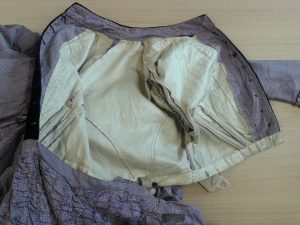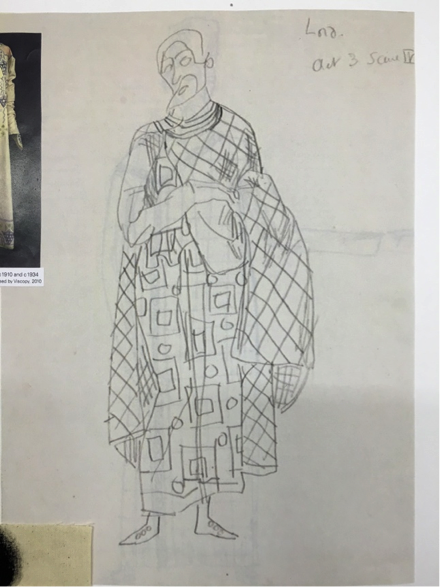Sarah-Mary Geissler (MA in Design and Material Culture), reflects on how one seemingly uninspiring garment led her to unexpected places…

Fig. 1: Front, side & back view of the 1880s Mauve Altered Afternoon Dress. Photo by Sarah-Mary Geissler
It really is amazing is how far one project can take you. From what started simply as a class presentation led to assisting lectures, journal publication and even curating a display just a year later!
During my final year studying the BA (Hons) Fashion and Dress History at the University of Brighton, we had the privilege of being taught by Professor Lou Taylor, pioneering dress historian. The spring term Special Subject module focused on case studies of objects in the Dress History Teaching Collection. Throughout her career, Taylor has amassed a wealth of dress objects which now reside at Pavilion Parade, an incomparable resource waiting to be utilised by students. Each piece has a fascinating backstory – rejected by museums, donated by alumni, rescued by students – though only a small percentage of the collection has been thoroughly researched. The aim of our module was to improve our own analytical and interpretive skills as dress historians, but also to provide a selection of objects with proper catalogue entries. The garment I had my heart set on was already selected by someone else, so I unenthusiastically settled on researching an 1888 Mauve Day Dress. I began the project totally convinced that there was nothing exciting about the Victorian era, and grumbled to friends how boring this project would be. I was so wrong!
Eventually I found how to apply my own interests to the research. Once I moved past my preconceptions of 19th Century dress, the analysis process became fascinating. I studied the dress inside and out, then compared it to other dresses from the period: it was clear that it wasn’t a straightforward example of 1880s fashion. As a dressmaker myself, the garment’s messy construction intrigued me. Other evidence in the garment led to the conclusion that it could have been an 1860s dress altered over 20 years. My project became a detective-style investigation into who the wearer was; where/when was the dress first made? Why was it altered so dramatically? And was this dress renovation typical for the period?
Throughout the assignment, I contacted several museum-based professionals regarding the dress, and became more confident networking as a researcher. I looked into museums policies regarding altered garments, and how different keepers of costume interpret their collections. Over the course of the module, I developed a specialist understanding of mid-late 19th Century home-dressmaking, strengthened my ability to read dress, learned how to properly mount costume, and found out a great deal about the theory of dress history and the field today. Outside of university, this project gave me the confidence to submit an exhibition review to Textile History Journal, which was selected for publication last November!
Knowing how invested I was with my case study, Professor Taylor asked me to assist with her first year lecture and object handling session, and to do a small talk about the dress. I was so nervous about speaking in front of a large group, but the session went brilliantly. It was surprising how much information I could recall about the dress; I started to feel like a proper historian! This year I was asked to help out again, and so came prepared with notes and printed images to aid my talk.
The success of this led to a conversation about displaying the dress in the School of Humanities’ Pavilion Parade foyer. With help from Clare in the office, mounting the dress was straightforward, though preparing information for the posters was challenging. I had to figure out what story was being told and how to make it interesting for a public viewer. Revisiting an undergrad project as a postgrad student, it was clear to see how much my work has strengthened in just a year (frustratingly, I found a spelling mistake on the first page of my original paper!). Displaying my research made me consider how museums and heritage sites interpret their collections, and this little display pushed me to develop my own curatorial skills.
All in all, I never expected the work done for one assignment to be the basis for such fantastic things. Having the Teaching Collection as a resource has been an invaluable part of my education at Brighton, and has reinforced the importance of understanding objects as sources of information to be read. I’ve been fortunate to have opportunities at the university to provide me with experience I can take into my career. It would be great for more students to get involved showcasing other pieces from the Teaching Collection in future, as there are many, many more fascinating stories to be shared!





